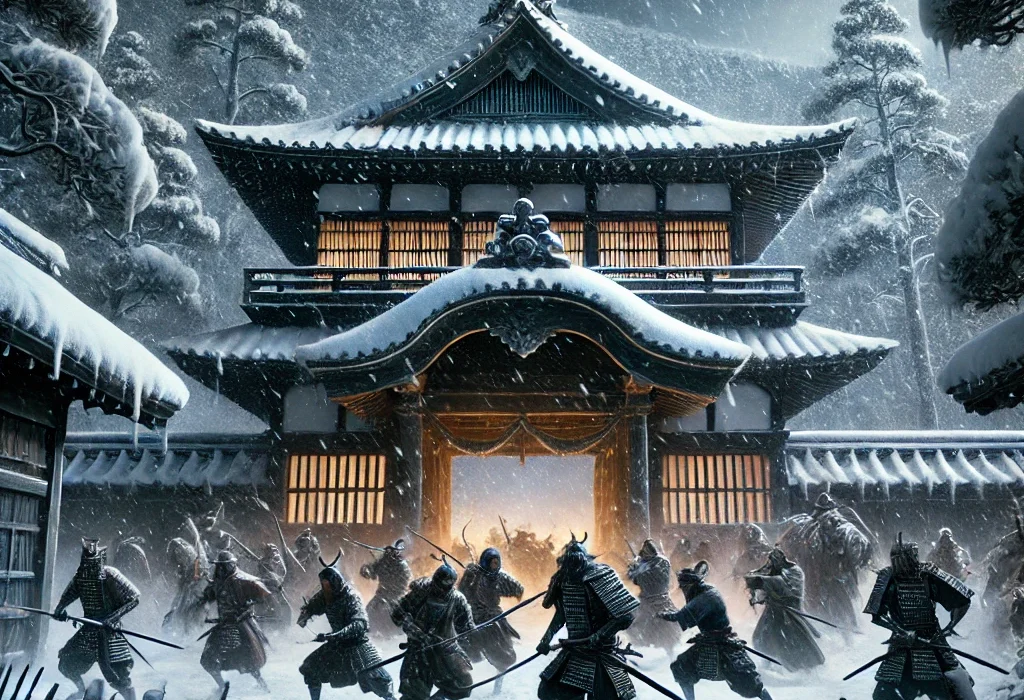“Tales of Old Japan” by Lord Redesdale is a collection of classical Japanese stories that paint a vivid picture of Japan’s culture, traditions, and societal values during the Edo period. Published in 1871, these tales were among the first to introduce Western audiences to the rich folklore and historical narratives of Japan. The collection includes various stories of heroism, revenge, love, and supernatural occurrences, providing a unique glimpse into the lives and beliefs of the Japanese people of that era. One of the most renowned stories in this collection is the tale of the Forty-seven Rônins, which exemplifies the themes of loyalty and honor deeply ingrained in the Samurai code.
Plot Summary
In the early years of the 18th century, there lived a nobleman, Asano Takumi no Kami, the Lord of Ako, a loyal vassal under the Shogun’s reign. One day, an Imperial envoy was sent to visit the Shogun’s court, and both Asano and another noble, Kamei Sama, were tasked with receiving the envoy and adhering to the court’s intricate ceremonies. To assist them, the court official Kira Kotsuke no Suke was appointed as their instructor. Kira, however, was a man of greed and pride, and he expected lavish gifts from the nobles he helped. Asano and Kamei offered their customary presents, but Kira found them unworthy and took to insulting them openly.
Though Kamei was filled with rage and planned to kill Kira, his wise retainers quickly pacified him by bribing Kira with a grand gift. Kira’s attitude toward Kamei softened, and the two nobles remained at peace. But Asano, who had not bribed Kira, continued to suffer his insults. Enduring for as long as he could, Asano’s patience broke when Kira mocked him one final time, commanding him to tie the ribbon of his shoe like a lowly servant. Asano, enraged, drew his dagger and struck at Kira within the palace walls. His blow only wounded Kira slightly, but such an attack in the Shogun’s palace was a grave offense. For this act, Asano was sentenced to commit hara-kiri, the ritual suicide, and his family’s lands were seized.
The death of Asano left his retainers, now ronin—masterless samurai—devastated. Forty-seven of them, led by Asano’s chief retainer Oishi Kuranosuke, swore an oath to avenge their lord’s death by killing Kira. But they knew their path would not be easy. Kira, expecting retaliation, fortified his home and placed himself under the watchful protection of his father-in-law’s men. The ronin, determined yet patient, waited for the right moment.
To deceive Kira and his spies, Oishi feigned a life of drunkenness and debauchery. He abandoned his wife and children, frequented brothels, and was often seen stumbling in the streets in a drunken stupor. His behavior convinced the authorities that he had given up any notion of revenge. Kira’s spies reported this to their master, who, reassured of his safety, slowly let his guard down. Time passed, and the ronin dispersed, taking on different occupations to avoid suspicion. But behind the scenes, Oishi carefully plotted the attack.
After nearly two years of waiting, the time finally came. On a bitterly cold night in midwinter, as snow blanketed the land, the ronin gathered in Edo, where Kira resided. Dividing themselves into two groups, Oishi and his men prepared to storm Kira’s residence. The attack began with the sounding of a drum, and the ronin entered the house from both the front and back gates, overwhelming Kira’s guards. They fought bravely, but none could match the determination of the ronin, who had long prepared for this moment.
As the battle raged inside the house, Kira fled and hid within an annex used for storing firewood. The ronin searched every corner, and just as despair began to creep in, one of them found a secret room. There, crouching in the darkness, was Kira, trembling and powerless. Oishi, recognizing the scar on Kira’s forehead from the attack by Asano, knew they had found their prey. He knelt before Kira and respectfully offered him the chance to die with honor by committing hara-kiri, as Asano had been forced to do. But Kira, paralyzed with fear, could not bring himself to do so. Seeing no other way, Oishi took up his dagger and beheaded Kira in one swift stroke.
With Kira’s head in their possession, the ronin left his residence. As the day broke, they marched through the streets of Edo, heading toward the temple of Sengakuji, where their master Asano lay buried. Along the way, onlookers marveled at the sight of these bloodied yet noble men. Upon reaching Sengakuji, the ronin washed Kira’s head in a well, placed it before Asano’s grave, and offered prayers for their master’s spirit. Their revenge, their duty, was complete.
They did not flee nor hide from what was to come. The ronin knew the consequences of their actions, for though they had avenged their lord, they had broken the law by killing Kira. They surrendered themselves to the authorities, and after deliberation, the government sentenced them to die by hara-kiri. Each ronin met their death with the same calm and resolve they had shown in life, embracing their fate as the ultimate fulfillment of their loyalty.
The graves of the Forty-Seven Ronin became a place of reverence, where people came to honor their memory. Their story spread across Japan, celebrated not only for their act of vengeance but for the steadfast loyalty and sacrifice that defined their lives. To this day, their graves remain a symbol of the unbreakable bond between a master and his retainers, and of the eternal spirit of bushido.
Main Characters
Oishi Kuranosuke – The loyal retainer of Asano Takumi no Kami, Kuranosuke leads the famous 47 Ronin in their quest for revenge. He embodies the values of loyalty, sacrifice, and strategic patience, driving the narrative of the legendary tale.
Asano Takumi no Kami – A noble lord whose unjust treatment by Kira Kotsuke no Suke leads to his forced hara-kiri (ritual suicide). His death sets off the main story of vengeance by his retainers, who seek to honor him even after his demise.
Kira Kotsuke no Suke – The villain of the 47 Ronin story, Kira is portrayed as corrupt and greedy. His humiliating behavior toward Asano provokes the lord’s fatal attack, and later, Kira becomes the target of the ronin’s meticulously planned revenge.
The Forty-Seven Ronin – A group of Asano’s samurai who, after becoming masterless, plot and carry out the revenge against Kira. Each character in the group, though sometimes only briefly mentioned, contributes to the central theme of loyalty and honor.
Theme
Honor and Loyalty – Central to the samurai code of bushido, honor and loyalty are recurring themes in many of these tales. The story of the 47 Ronin is the ultimate expression of loyalty, where samurai go to great lengths, even sacrificing their lives, to avenge their lord and restore his honor.
Revenge – A motif that features prominently, especially in the story of the 47 Ronin. The tales delve into the complex nature of revenge in feudal Japan, where retribution is seen as both a moral and personal duty.
Supernatural Elements – Many stories incorporate ghosts, demons, and otherworldly creatures, reflecting the deep spiritual beliefs of the Japanese people. These supernatural tales highlight the importance of religion, fate, and the unseen forces governing human life.
Sacrifice – The concept of self-sacrifice, particularly in the name of duty, is explored in several stories. Whether through ritual suicide (hara-kiri) or enduring hardship for a cause, the characters often place their obligations above personal desires.
Writing Style and Tone
Redesdale adopts a descriptive, almost scholarly style, often infusing the tales with detailed backgrounds and historical context. His tone remains respectful of the source material, aiming to present these Japanese stories as both exotic and profound to a Western audience. The narrative is imbued with admiration for Japanese customs, especially the stoic dedication to duty and honor seen in the samurai class.
The prose tends to be formal, reflecting the Victorian sensibilities of Redesdale’s time, but it is interspersed with vivid imagery that brings the settings and actions of the characters to life. The author’s experience in Japan enables him to capture the complexities of Japanese social hierarchies and cultural practices, while maintaining a certain poetic elegance in the retelling of these stories.
We hope this summary has sparked your interest and would appreciate you following Celsius 233 on social media:
There’s a treasure trove of other fascinating book summaries waiting for you. Check out our collection of stories that inspire, thrill, and provoke thought, just like this one by checking out the Book Shelf or the Library
Remember, while our summaries capture the essence, they can never replace the full experience of reading the book. If this summary intrigued you, consider diving into the complete story – buy the book and immerse yourself in the author’s original work.
If you want to request a book summary, click here.
When Saurabh is not working/watching football/reading books/traveling, you can reach him via Twitter/X, LinkedIn, or Threads
Restart reading!








